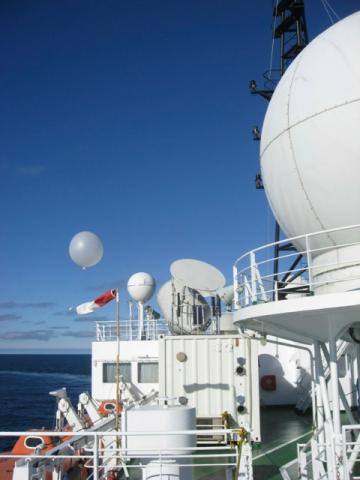RV Mirai is now well south of the ice edge and has taken up station at 72º45’N 168º15’W for approximately two weeks of concentration observations below and above the surface. One of the research points of focus on this Fixed Point observation series is Senior Met Officer Jun Inoue’s study of Arctic cyclones. During the two week period between 11 and 24 September shore side weather stations and RV Mirai have set up increased radiosonde data collection from the usual 3 per day to 8 per day to gather data for Jun’s study. The study hopes to gain further insight into the development of Arctic cyclones that can develop extremely rapidly and without the normally understood drivers such as ocean currents. The ultimate goal is to develop more accurate forecasting models that can better predict the often rapid growth and high intensity of Polar Lows.
To gather the data, every three hours the Mirai alters heading to get relative wins off the port bow. Starting about one hour before the observation time (every three hours commencing at 0000UTC), Jun and his team begin to inflate the balloon and prepare the disposable radiosonde. The quantity of helium is calculated for each launch based on true winds and temperatures to ensure that the ballon has sufficient lift to clear the eddy currents around the ship as it leaves the automated launcher, but not too much to rise too quickly. The radiosonde itself is calibrated against “true” sea level pressure and temperature as well as true launch latitude and longitude. The balloon is inflated inside an automatic launch tube in the portable met lab secured on the mid bridge deck. The launch tube will rise clear of the lab on command, then swivel and tilt to allow the balloon to come free and move clear of the ship downwind. Thirty minutes before the observation hour the ship alters course if necessary and the balloon is sent on its way, transmitting its valuable data.
In addition to the additional radiosonde launches, the Mirai’s Doppler Weather radar is operating 24hrs a day and sea level pressure, both air and sea surface temperatures, relative humidity, precipitation, true wind speed and direction, significant wave height and long and short wave radiation data are collected.
Jun points out that with the huge open expanse of the Arctic Ocean, there will rarely be a fully equipped weather monitoring ship in the middle of the ice able to launch radiosondes at regular intervals to ensure as complete a picture of current conditions as possible. With his research he hopes to at least to provide data that will allow each Arctic country to improve its particular weather forecasting model to ensure timely and more accurate weather forecasting throughout the Arctic based on optimal frequency of radiosonde launches from shore based weather reporting stations that do exist.
Capt David (Duke) Snider
Ice Navigator
RV Mirai
Photo: Automated launch of radiosonde balloon from RV Mirai met lab. Doppler weather radar dome to right.

